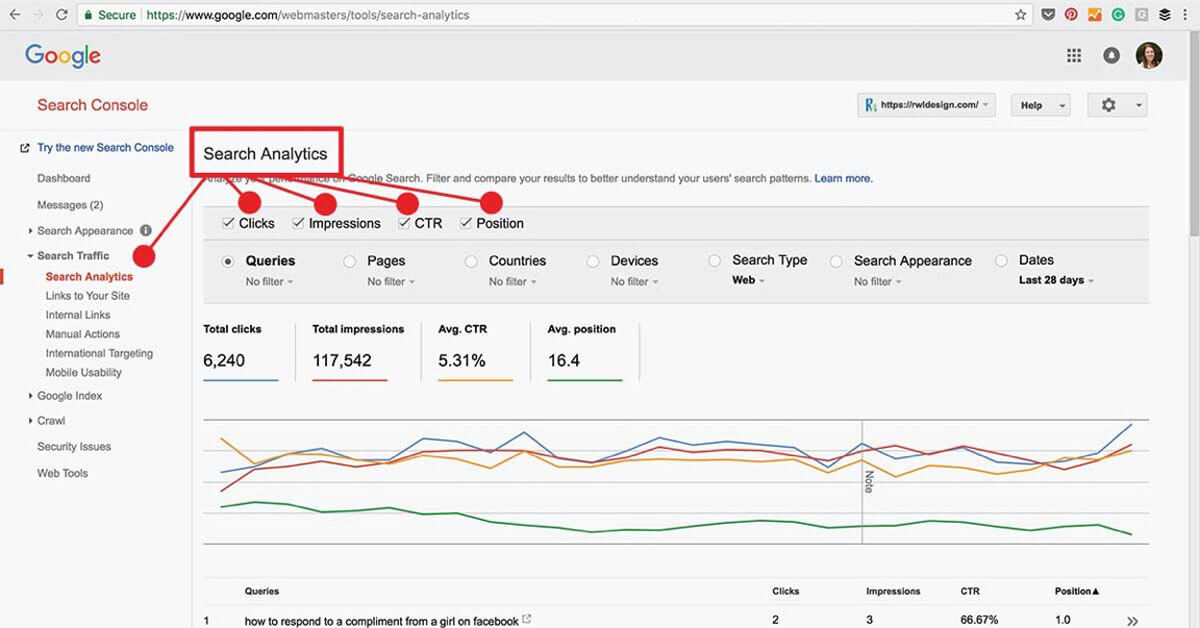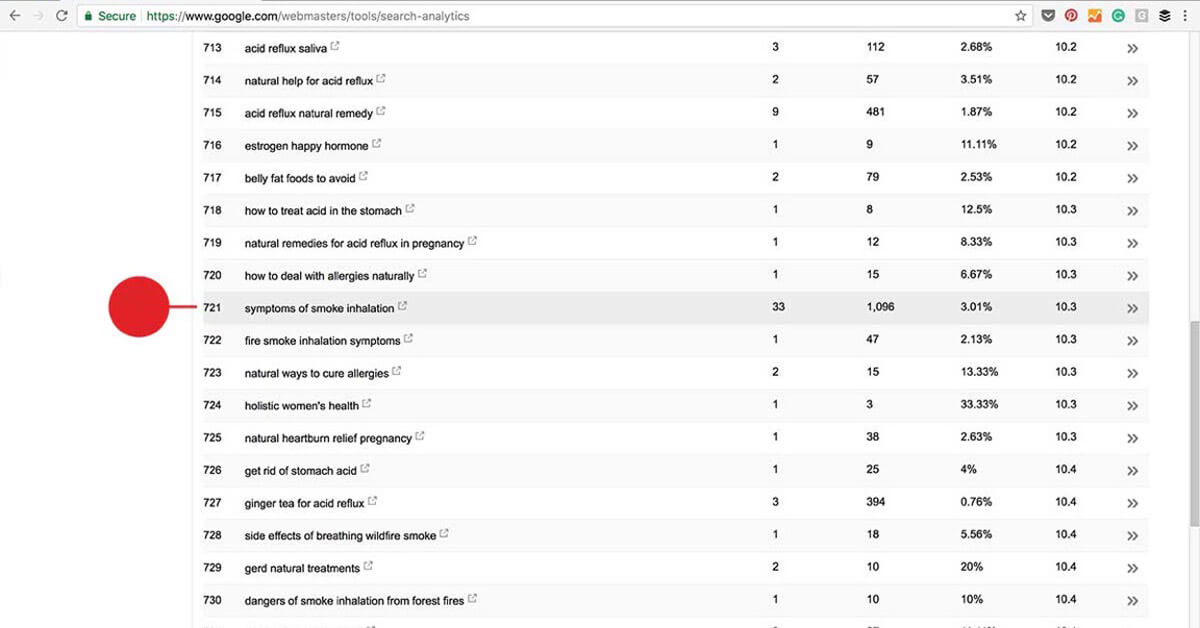
If you read most articles about content marketing, they’ll discuss delivering value and creating engagement. They may mention SEO. They’ll probably talk about images and video.
They might even rave about earning Google’s coveted spot zero and how to create evergreen content. But ultimately, all assets of content marketing on the web come together to achieve one goal – improving your website’s rank.
Content Marketing is a Long-Term Investment

Did we really just talk about ‘rank’ as the ultimate goal? Yes. And here’s why.
Rank ultimately correlates to more sales. As content marketing attracts traffic and inbound links, your site’s domain authority improves. This increases in your site’s rank, resulting in more organic traffic to your services pages (aka leads) and more sales.
Here’s the flow chart:
Content Marketing Brings Traffic + Inbound Links -> Domain Authority Improves -> Site Rank Increases -> Organic Traffic to Service Pages Increase -> Sales Skyrocket
Like any valuable relationship, content marketing’s not a one-and-done transaction. It’s an investment. Yes, there are instances where a content marketer will hit it out of the park within the first month of launching your campaign. But for the most part, your business will really see the return when months and even years later when the content you’ve published is still attracting traffic.
Content Marketing Isn’t a New Trick. It’s Been Around for Ages.

What’s old is always ‘new’ again. In 2017, food bloggers treated cauliflower like it was a newly discovered vegetables. Fashionistas are raving about bell bottoms, like the trend never happened in the 70s. Designers like to tout the ‘rule of 3’ as though they’re the first ones to utilize it. Content marketing is no different.
One of the first official pieces of content marketing was published in 1895 – more than 120 years ago! John Deere published the first issue of The Furrow, an agricultural magazine that highlighted relevant details and included advertisements.
That’s one of the things to remember about content marketing — it’s not necessarily web-based. In fact, it wasn’t originally. Content marketing can include:
Sponsored articles in trade journals
Newspaper reviews
Magazine ads
TV ads
Product placement within TV shows
User-generated content (aka influencer marketing)
Blog posts
Sponsored blog posts
Guest blog posts
Landing pages
Social media content
How Digital Content Marketing Builds Your Site’s Rank

In ConversionXL’s ‘Content strategy and SEO for lead generation’ class, Andy Crestodina, equated website rank to high school popularity. As one would expect of a digital marketing expert, Crestodina’s not wrong.
Like the captain of the cheer squad, a website’s rank is fueled by those who recognize its authority. In high school, this equates to copying hairstyles and t-shirt trends. In the digital world, it’s much the same story.
Inbound links and site quotes signal to search engine powers like Google that your site is ‘one of the cool kids’ so to speak. Why’s this matter?
Because the hottest date for the Google rank party is Spot Zero (aka the quick answer box). Earning one of those placements can substantially drive traffic to your site, which in turn strengthens the relevance of all your pages. While Google’s algorithms are (and will always be) closely guarded secrets, some insights have been gleaned over the years as to what improves rank. These factors include:
Relevancy – Is the information you’re providing the most relevant to the search query?
Backlinks – Linking to someone else’s content is a great way to show your audience that it’s well researched. However, this doesn’t help build your rank. Rather, backlinks signal to Google that your site is valued and respected by others.
Responsive – Does your site perform well on mobile devices? With mobile’s ever-growing popularity, a mobile-friendly site isn’t just a good thing. It’s expected.
Page Speed – Your audience doesn’t want to wait for your page to load. Google knows this. Which means the faster your page loads, the better your site’s rank will be.
Time on Site – Time on site signals to Google that readers are reading your content, meaning they find it valuable.
Bounce Rate – Are people clicking to your site and leaving immediately? This signals to Google that users aren’t finding your site helpful.
Content Length – This is not a hard and fast rule, but often pages with some meat (aka a chunk of content) rank higher. A page or blog post with just a few short lines rarely delivers very much helpful information.
Targeting the Right Keywords – It’s not always about going after the keywords for which you want to rank. Rather, it’s about targeting the keywords your ideal visitors are using to answer their questions. This requires not only SEO research, but looking closely at user feedback and reviews.
Keywords Used Correctly – Google tries to find a relevant match to what the user is searching for. Keywords help signify your relevance. This doesn’t mean slamming (aka spamming) the keyword everywhere. (Google will penalize you for this.) Rather, it means using the keywords in meaningful ways at key points throughout your piece - including related phrases and terms.
3 Practical Tips to Improve Your Site’s Rank with Content Marketing
As with all aspects of life, some steps are easier than others. What follows are some practical tips your content marketing team could start taking to improve your rank.
1. Use Google’s Search Console to go After Low Hanging Fruit
Google’s Search Console is a nifty tool that allows you to see the exact keywords individuals are searching to find your site, how often those keywords result in a click, and where your site ranks for those keywords.
From the Search Console dashboard go to Search Traffic -> Search Analytics
Select Clicks + Impressions + CTR + Position + Queries
Filter by Position

- Skip forward through the results until you reach Positions of 10 or higher. Look for keywords in this position with a higher number of clicks and impressions.

These keywords are low hanging fruit. By searching for that keyword, you can see the pages for which that keyword is ranking. Sometimes, all it takes to improve rank is making a few SEO updates to the existing page. This could include updating the Page Title, Meta Description, and Headers.
In other instance, you may consider creating a new piece of content that targets that keyword specifically. This will not only increase your digital footprint for this specific topic, but it allows you to interlink the content, helping to increase click-throughs.
2. Submit Guest Blog Posts
Looking to increase your inbound links? A guest blog post is a sure bet. In some instances, you may be able to link to your own content. At the very least, a guest blog post author byline should link back to your site.
As you think about where to submit guest posts, it’s important to consider:
Is my topic relevant to this site? If not…look elsewhere.
Does this site accept guest post submissions? It not, don’t waste your time.
Does this site have guest post submission guidelines? If so…be sure to read them and follow them!
3. Alert Anyone Mentioned
Mentioned someone in one of your blog posts? Let them know! Send them an email. Credit them in a Tweet or Facebook post.
Everyone likes to be mentioned. And, they like to highlight that they’ve been mentioned. Give them the opportunity to do so. This helps turn the person you mentioned into your own personal marketer, driving more traffic to your content.
Furthermore, it can help you create stronger relationships with these respected individuals. They may even link back to your site.
Could Content Marketing Help Your Business?
While we believe nearly every business could benefit from a strong content marketing plan, we also believe content marketing isn’t one-size-fits-all. The best content marketing plans are created with your business goals in mind and scaled to fit your needs.
CTA: Let’s talk about what you want to achieve and how content marketing can help.
More Content Marketing Insights
Why Hire a Professional Content Marketing Team
Need help with your content marketing, but aren’t sure about outsourcing? Discover the pros and cons of utilizing a professional team. Ultimately, it comes down to who has the time and expertise to be effective and deliver a positive return on investment.
Content Marketing vs. Blogging?
Tired of dumping money into marketing that doesn’t deliver results? A strategic content marketing campaign becomes a lead-generator that strengthens your business.
Evergreen Content Attracts Long-Term Organic Traffic
Tired of investing in content development stops performing after a short time? Maximize your ROI with an evergreen content strategy. Discover how your blog posts can continue to provide inbound leads months and even years after they’ve been published.





